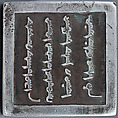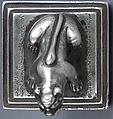On loan to The Met The Met accepts temporary loans of art both for short-term exhibitions and for long-term display in its galleries.
Imperial Seal of the Prince of the Dörbed (Four Children) Banner
The Qing emperors consolidated their rule over Inner Mongolia by recognizing the title of prince held by leaders of various Mongol fiefdoms. These fiefdoms were then organized into territorial units known as banners. In return for their loyalty and military support, the princes received full and inalienable rights to rule their banners in alliance with the Qing. To signify that power and authority, the emperor gave each prince a silver seal, surviving examples of which are now exceptionally rare. These imperial seals were inherited by successive princes and venerated as sacred objects, while also embodying the banner’s status and legitimacy within the empire.
Emperor Kangxi (reigned 1662–1722) bestowed this seal on the leader of the Dörbed (Four Children) Banner to formalize the banner’s acceptance of Qing sovereignty in 1686. On the underside of the base of this seal, cast in raised letters, is the phrase, in Manchu and Mongolian, Seal of the Prince of the Dörbed Banner. The same phrase is also engraved on top of the base at either side of the tiger, in Manchu on one side and Mongolian on the other. The dual language inscription, Made by the State Ministry, is engraved on the front and back edges of the base; and, Kangxi twenty-fifth year, fourth month [a.d. 1686] is engraved on the side edges of the base.
Due to rights restrictions, this image cannot be enlarged, viewed at full screen, or downloaded.
This artwork is meant to be viewed from right to left. Scroll left to view more.








